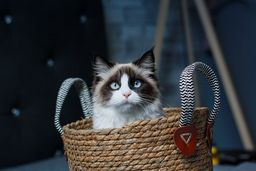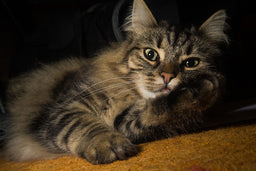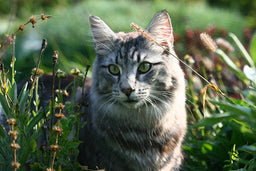Variety is the spice of life—all the types of Siamese cats explained
As one of the most exotic-looking breeds, the Siamese is a perennial favourite among cat lovers.
Despite haughty looks and a demeanour indicating that Siamese cats might be aloof and distant, they are, in truth, friendly, affectionate, and remarkably intelligent.
Siamese kitties are also relatively low-maintenance regarding diet, healthcare, and grooming. Compared to other breeds like Sphynx, Persian, or Munchkin, Siamese felines don’t need a lot of care.
Attention is a different matter, and your alone time may be reduced to a minimum with a Siamese in the house.
Of all the varieties of Siamese cats you could choose, which one should you go for? Untamed offers a breakdown of the various types of Siamese cats, their markings, colour, and personality traits.
Traditional or modern Siamese—who is who?
The shape and markings of Siamese cats have been developed by selective breeding, but three basic body shapes have endured, namely the:
- Wedgie or Wedge Head
- Classic or Old Style
- Applehead or Traditional
The Wedgie or Wedge Head
The Wedgie or Wedge Head is the most recent variant of the Siamese body shape and the one typical of the breed.
The shape was only brought to prominence during the 1970s and 80s by breeders hoping to meet exacting breed standards.
The Wedge Head Siamese has a triangular face, a long body, and a lithe, muscular physique.
The ears appear prominent due to the shape of the head, and the blue, slanted eyes can seem disproportionately large.

The height of fashion—the bang-up-to-date Wedgie.
Source: Pixabay
The Classic or Old Style
The Old Style Siamese cat sits between the Wedgie and the Traditional in terms of looks.
With the same lithe physique as the Wedgie, the Old Style has a rounder head, giving them a less distinctive appearance.
The shape reached the height of popularity in the 50s and 60s but has now largely been supplanted by the Wedgie.

50s style with an ornamental Classic Siamese.
Source: Pixabay
The Applehead or Traditional
The Applehead is the closest to the original Siamese cats imported into the U.S. during the early 1800s from what is now Thailand.
With a rounder face and stockier body, the Traditional resembles a small, short-haired Ragdoll or even a British Shorthair.
Siamese colour variations
Siamese can come in several colour variations, as follows:
|
Name of variant |
Colour and markings |
|
Seal point |
|
|
Blue point |
|
|
Lilac point |
|
|
Chocolate point |
|
|
Colour point shorthair |
|
Siamese cats are generally short-haired, but a longer-haired version has now been designated a separate breed, known as the Balinese.
Whatever colour variation you prefer, you should be aware of the personality you will be letting into your home.

“Yes, I know I’m gorgeous.”
Source: Pixabay
Do different types of Siamese cats have different personalities?
Regardless of the colour or shape of your Siamese cat, they will have quite a personality.
Siamese kitties are friendly and highly attached to their families. The crucial facets of their personality and behaviour are their:
- Cuddle addiction
- Need for company
- Choice of one special friend
- Mood sensitivities
Cuddle addiction
Siamese cats are avid cuddlers and similar to Ragdolls and Maine Coons in their desire for contact. They will seek you out and use you as a cushion all the time.
Need for company
Siamese felines hate solitude and can quickly become anxious.
If your lifestyle involves long periods away from home, you should consider whether the Siamese is the right cat for you.
The symptoms of anxiety in a Siamese can be:
- Refusal to eat
- Destructive behaviour towards inanimate objects
- Prolonged sleeping
If you come home to find your house trashed and your kitty fast asleep in a hideaway, you may have been away too long.
You should also be prepared for serious and prolonged vocal abuse, so ear protection might come in handy.
Choice of one special friend
In larger families, a Siamese may choose one family member and single them out for special attention.
If that person is you, expect constant company bordering on stalking, the inability to sit anywhere without being used as a sofa, and little chance of working on a laptop or reading a book or newspaper.
Mood sensitivities
Siamese cats react quickly to raised voices or harsh words.
They will often disappear at the merest hint of an argument and respond poorly to chiding or being told off.
Positive reinforcement of good behaviour is the only way to train your Siamese—any other method will result in intransigence or the school being unilaterally declared closed.
You may even get the biting treatment, in which Siamese will make their feelings known with the—albeit gentle—use of teeth.
Siamese cat varieties and their health needs
Similarly to the more exotic Asian, African, or Oriental cat breeds—such as Abyssinians, Burmese, or Bengals—Siamese cats (regardless of their type) are prone to several disorders that demand your care and attention.
The most common issues are:
- Liver disease
- Dental problems
- Asthma or breathing difficulties
- Various forms of cancer
Liver disease
The breed is prone to amyloidosis, affecting liver function.
This condition is hereditary, occurring within Siamese families and usually screened for by breeders.
If a cat slips through the net, the disease can spread to the kidneys, entailing the following symptoms:
- Mouth ulcers and oral pain
- Rapid weight loss
- Chronic nausea and vomiting
- Dehydration
Once the kidneys are affected, the condition can’t be reversed, so early screening is essential.
Dental problems
Siamese cats can develop dental issues and lose teeth in later life because of the shape of their head. While tooth loss isn’t a significant cause for concern, you may notice short-term refusal to eat due to pain in your cat’s mouth. The issue is more common if your kitty’s diet consists of dry kibbles.
Any change in your cat’s eating habits is a cause for concern, and anorexia in older cats is worrying as it can lead to rapid weight loss. If you notice dental problems, consider switching to wet food to make eating easier.
Asthma or breathing difficulties
Head shape can cause restrictions in your Siamese’s airways, making breathing difficult.
On top of this, Siamese cats can suffer from asthma and other allergies, such as hay fever. Most symptoms can be relieved with medication, but you should always be vigilant and watch for breathing problems.
Various forms of cancer
Siamese cats are at risk of all forms of cancer. To be safe, you should arrange regular screenings (optimally twice a year) to detect any signs of this nasty disease as early as possible.

Autumn hunting trip!
Source: Pixabay
Do different Siamese cats need different food?
Regardless of the type, Siamese nutritional needs remain the same. Feeding your feline the best food is essential to ensure they don’t fall prey to:
Gastrointestinal disorders
Siamese cats are not prone to allergies or overly sensitive, but they can experience tummy upsets, usually resulting in:
- Diarrhoea
- Vomiting
- Disinterest in food
- Occasional allergic reactions with visible skin irritation
Weight problems
Even though they are active and boisterous cats, Siamese can develop middle-age spread as adults. Being overweight carries an increased risk of diabetes, joint and mobility issues, and hyperthyroidism or heart problems.
The best weight management strategy for felines is a rigorous, healthy diet and regular exercise.
Urinary tract infections (UTIs)
Cats have highly sensitive urinary tracts, and the risk of UTIs such as cystitis or struvite stones is ever-present.
UTIs can be pretty painful but usually clear up if treated promptly.
How can food help your Siamese stay fit and healthy?
The right nutrition can do wonders for your Siamese. Cat food containing healthy ingredients can help alleviate most niggles your kitty can face at any age—from kitten to senior.
The healthiest products should have:
- Animal protein
- Animal fat
Animal protein
Nothing beats meat or fish when it comes to cat food. They are the best sources of protein and essential amino acids—like taurine.
Animal protein has a beneficial effect on:
- Skin and coat
- Muscles
- Urinary tract
- Digestion and nutrient absorption
There’s a wide range of cat food types—wet, dry, semi-moist, homemade, or B.A.R.F.—but you should always check the ingredients list or recipe. One of the following should be listed first:
Avoid any food with vegetable protein because cats cannot break them down properly. Steer clear of:
Animal fat
Besides being an excellent source of essential fatty acids, animal fat makes food taste fantastic to felines, especially in cat jelly or gravy.
A diet containing more than 50% animal protein and up to 20% animal fat will give your feline all the calories, nutrients, vitamins, and minerals they need for a happy and healthy life.
Is Untamed good for all types of Siamese cats?
Untamed is an excellent choice for your Siamese friend! With twice as much protein as most commercial products, Untamed will give your cat what they need for an active, fulfilled life.
Each Untamed recipe—whether you choose Chocka Chicken, Tuck-in Tuna, Full-on Fishy—provides top-notch nutrition combined with great taste.
All our products have been formulated by vets to ensure your kitty gets the best of the best, and you can tailor-make their meal plan to suit their life stage and taste preferences.
Untamed is a responsible and eco-friendly business, and we insist on:
- Fully recyclable packaging
- Cruelty-free and sustainable suppliers
- A 100% carbon-neutral supply chain
With all this goodness on offer, all you need to do for your Siamese is order Untamed today!

What your Siamese needs and deserves!
Image (c) Untamed
Get Untamed for your Siamese
Getting Untamed for your Siamese couldn’t be easier—all you need to do is:
- Give us some info about your Siamese friend
- Pick the products
- Order your initial trial pack
Once your trial pack arrives, you can regale your Siamese with food fit for the king (and I). We will make sure the larder is always full, so your kitty won’t have to suffer through an occasional subpar dinner.
Here’s how our clients describe the Untamed effect:
|
Timeline |
What Untamed can achieve |
|
After 1 week |
|
|
After 2 months |
|
|
Within 4 months |
|
|
Life-long |
|



